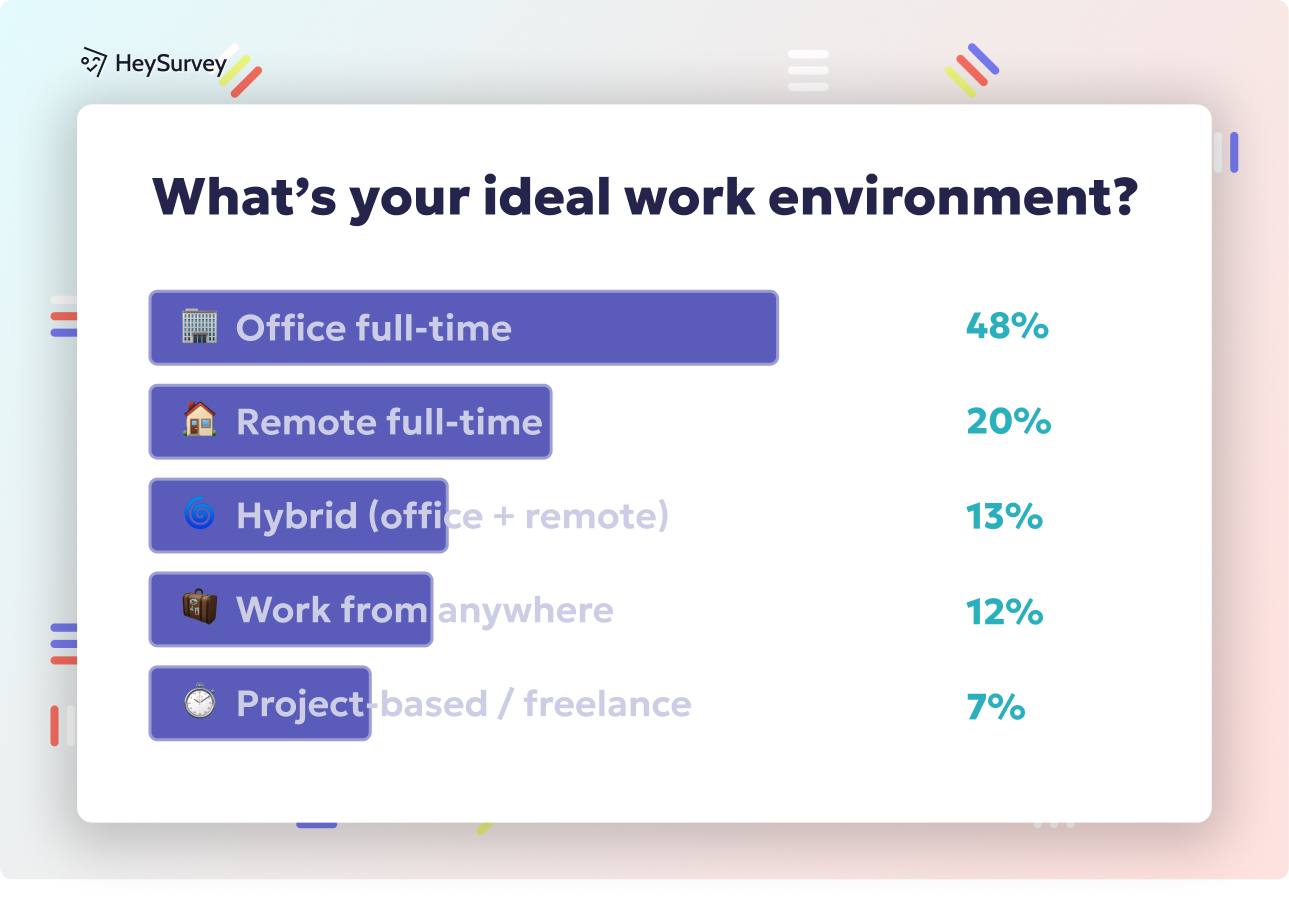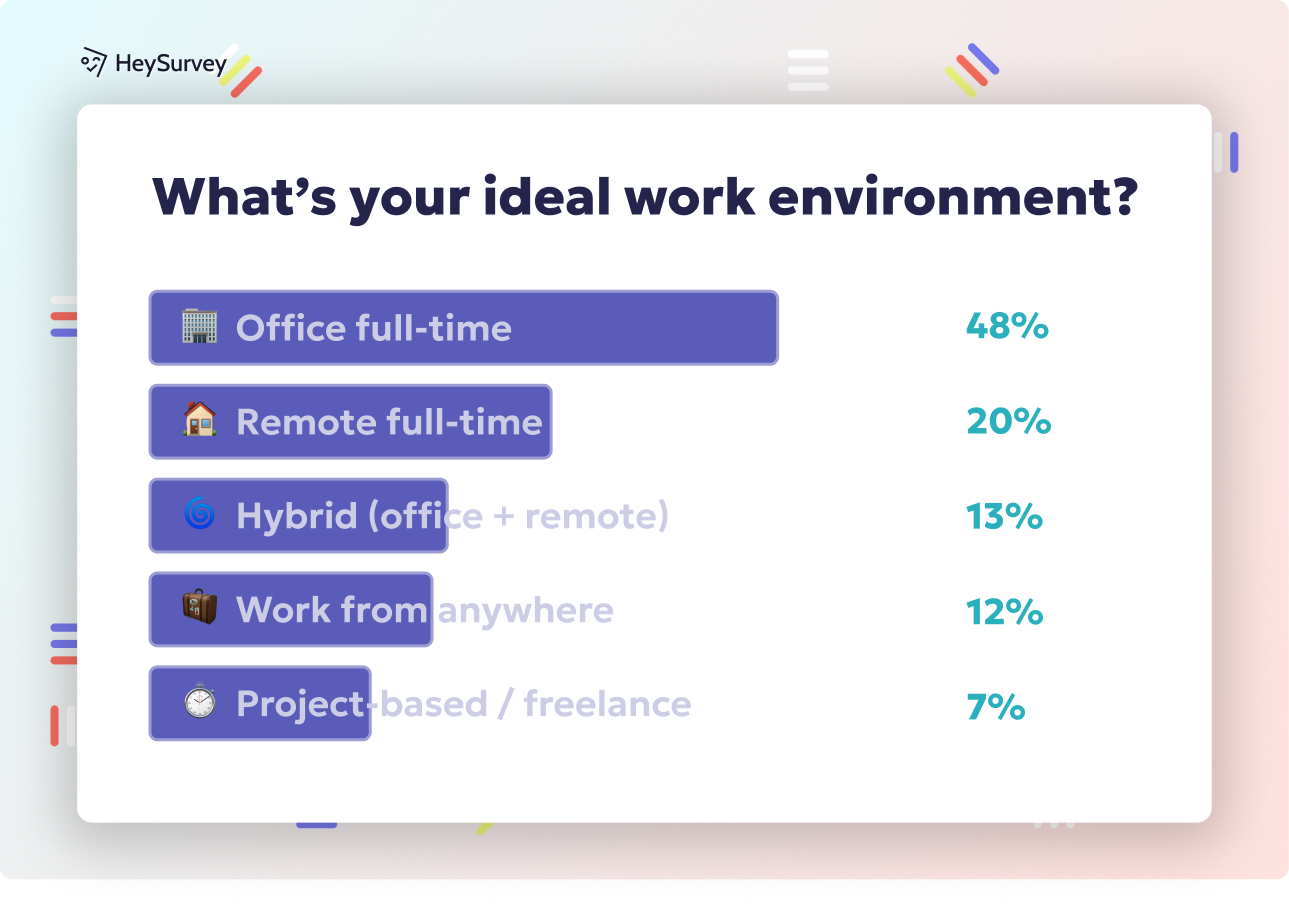30 Gender Survey Questions: Crafting Inclusive, Insightful Surveys
Explore 25+ inclusive gender survey questions with expert tips on crafting respectful, accurate, and effective gender survey questions.
More and more organizations are learning just how important gender survey questions can be. Whether you’re refining your company’s DEI efforts, tuning your marketing, or improving the patient experience, how you ask about gender matters. Inclusive, well-crafted gender questions help you gather accurate data, make everyone feel respected, and avoid awkward legal snafus. In this guide, you’ll find smart strategies, inclusive gender options, and actionable examples across different types of surveys—telling you exactly how to ask gender on a survey no matter your field.
Employee Demographic Surveys
Understanding Workforce Demographics
Collecting data about gender at work is not just a tick-box activity—it shapes how organizations approach fairness, benefits, and representation. Modern HR teams use an employee gender survey to uncover hiring patterns, spot pay gaps, and launch Employee Resource Groups (ERGs). With the world watching, companies need to show they care about inclusion, not just compliance.
When to Use This Survey
Great times to break out a workplace diversity questionnaire include:
- Kicking off annual DEI pulse surveys to track progress.
- Adding self-ID questions to onboarding and new hire forms.
- Running a culture survey when launching inclusion initiatives.
- Collecting voluntary updates for pay-equity audits and ESG disclosures.
- Fulfilling mandatory Equal Employment Opportunity (EEO) reporting.
You want to use these surveys when context matters—when privacy, trust, and giving people a real choice are part of the process.
Sample Gender Questions for Employees
Modern workplaces lead with respect and options. Here are sample survey questions that show care for every employee’s identity:
Which of the following best describes your current gender identity?
- Woman
- Man
- Non-binary
- Genderqueer
- Prefer to self-describe: __________
- Prefer not to say
- Woman
Is your gender identity the same as the sex you were assigned at birth?
- Yes
- No
- Prefer not to say
- Yes
Do you identify as transgender?
- Yes
- No
- Prefer not to say
- Yes
How comfortable do you feel sharing your gender identity at work?
- Very comfortable
- Somewhat comfortable
- Neutral
- Somewhat uncomfortable
- Very uncomfortable
- Very comfortable
What workplace resources would better support your gender identity? (open-ended)
Such questions create a sense of belonging. They pave the way for better policies and a more welcoming office culture.
Inclusive gender survey questions should use respectful language, offer diverse response options, and ensure respondent privacy to accurately reflect workforce diversity. (payequitychrc.ca)
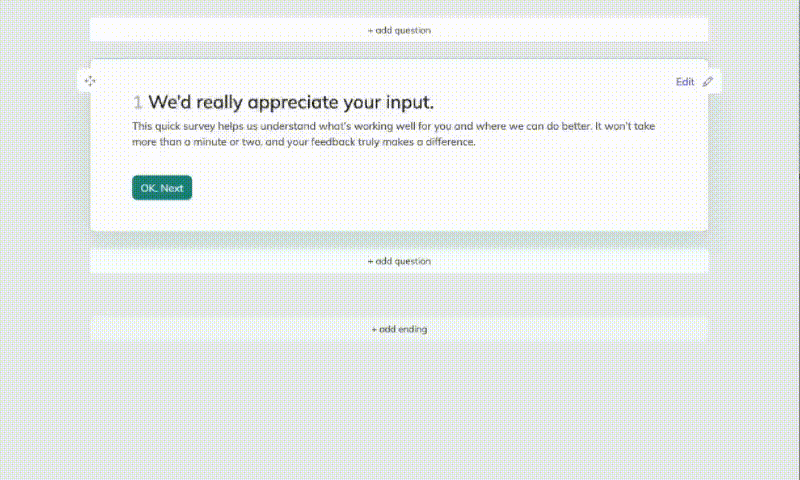
How to Create an Inclusive Gender Survey with HeySurvey in 3 Easy Steps
Ready to build your own inclusive gender survey using HeySurvey? Don’t worry if this is your first time—just follow these simple steps to get your survey up and running quickly. When you’re done, you can start with a handy template by clicking the button below!
Step 1: Create a New Survey
- Open HeySurvey and select Create New Survey.
- Choose either an Empty Sheet to start fresh or pick a Pre-built Template if you want a ready-made structure to work from.
- Give your survey a clear internal name so you can find it easily later (for example, “Employee Gender Demographics 2024”).
- Click Create to enter the Survey Editor, where you’ll add your questions.
Step 2: Add Inclusive Gender Questions
- In the Survey Editor, click Add Question at the top or between existing questions.
- Select the question type that fits your needs (most gender questions are Choice or Text for write-in options).
- Add your question text, for example: “Which of the following best describes your gender identity?”
- Enter gender options such as: Woman, Man, Non-binary, Prefer to self-describe (with a text box), and Prefer not to say.
- Use the Other choice if you want respondents to write in their identity.
- Mark questions as required only if you truly need the data, and consider including a Prefer not to say option to respect privacy.
- Continue adding any follow-up or related questions (like pronoun preferences or comfort levels) by repeating this process.
Step 3: Publish Your Survey
- Click the Preview button to see how your survey looks on different devices and make any design tweaks.
- Once you’re happy, hit Publish—please note this requires an account.
- Copy the shareable link that HeySurvey generates and send it to your audience or embed it on your website.
- Monitor responses from your HeySurvey dashboard whenever you like.
Bonus Steps to Make Your Survey Shine
Apply Your Branding
- Open the Branding & Settings Panel.
- Upload your organization’s logo to appear on the survey header; this strengthens recognition and trust.
- Customize colors, fonts, and backgrounds in the Designer Sidebar to match your brand’s style.
Define Survey Settings
- In the settings panel, set Start and End Dates for survey availability if you want to limit when responses can be collected.
- Specify a response limit to close the survey after hitting your target number.
- Add a Redirect URL to send respondents somewhere special after completion—like a thank-you page.
- Decide if you want to let respondents view aggregate results when they finish.
Use Branching Logic for Personalization
- Use HeySurvey’s branching features to redirect respondents based on their answers.
- For example, if someone answers “Yes” to identifying as transgender, branch to questions about gender-affirming resources.
- Branching creates a more relevant and respectful survey flow, improving user experience and data quality.
You’re now fully equipped to craft an insightful, respectful, and beautifully branded gender survey with HeySurvey. Ready to get started? Simply hit the template button below and watch your survey come to life!
Customer Persona & Feedback Surveys
Gender in the Customer Experience
Forget cookie-cutter demographics—a customer gender demographics approach in surveys means better segmentation and smarter marketing. Companies thrive when they see their audience as individuals with rich, diverse identities. How brands ask about gender determines if customers feel seen or overlooked.
When and Why to Use These Surveys
You’ll want to use these insights for:
- Fresh post-purchase feedback to improve offerings.
- Sign-up pages that collect optional, inclusive responses.
- Personalizing loyalty program experiences without invading privacy.
- Usability studies that check if your brand speaks to everyone.
- Ensuring compliance with privacy laws like GDPR and CCPA.
It’s about more than ticking boxes; it’s about building a culture of gender identity marketing that puts people first.
Sample Gender Questions for Customers
Ready to refine your message, imagery, and products? Here are inclusive sample questions:
How do you currently describe your gender?
- Woman
- Man
- Non-binary
- Gender-fluid
- Prefer to self-describe: __________
- Prefer not to say
- Woman
Which pronouns do you prefer we use when communicating with you?
- She/her
- He/him
- They/them
- Other: __________
- Prefer not to say
- She/her
Does our product imagery reflect your gender identity?
- Always
- Sometimes
- Rarely
- Never
- Always
Rate how inclusive you find our brand’s gender representation.
- Extremely inclusive
- Very inclusive
- Somewhat inclusive
- Not very inclusive
- Not at all inclusive
- Extremely inclusive
What can we do to make our offerings more gender-inclusive? (open-ended)
This approach makes customers feel valued, rather than market-tested. It also helps companies steer clear of gendered gaffes and deliver more personal experiences.
Including a gender pronoun question in surveys significantly increases satisfaction and comfort levels among genderqueer participants. (pubmed.ncbi.nlm.nih.gov)
Academic & Social Science Research Surveys
Robust Data for a Changing World
In research, asking about gender isn’t just routine—it’s foundational for understanding social patterns and health trends. Yet terms and identities evolve, so the gender identity research survey has to keep pace. Scholars, IRBs, and community leaders need questions that honor both standardization and lived experience.
Why and When to Use
These surveys matter most for:
- IRB-approved social science or medical studies.
- Student or campus diversity questionnaires.
- Behavioral and community health research.
- Longitudinal studies comparing past and present identities.
Researchers balance comparability with past datasets and the need to use up-to-date, affirming language.
Sample Gender Questions for Academic Surveys
The two-step gender question method is considered best practice for clarity and inclusivity. Here’s how to ask:
What sex were you assigned at birth?
- Female
- Male
- Prefer not to say
- Female
What is your current gender identity?
- Woman
- Man
- Non-binary
- Genderqueer
- Prefer to self-describe: __________
- Prefer not to say
- Woman
Do you consider yourself non-binary, gender-fluid, or gender-queer?
- Yes
- No
- Prefer not to say
- Yes
How important is gender to your personal identity?
- Extremely important
- Very important
- Somewhat important
- Not very important
- Not at all important
- Extremely important
Have you experienced discrimination based on gender identity in the past 12 months?
- Yes
- No
- Prefer not to say
- Yes
Please share any additional comments about your gender identity. (open-ended)
These nuanced, respectful questions make research more meaningful and empower participants to share openly.
Healthcare & Patient Intake Surveys
Delivering Affirming, Accurate Care
In healthcare, how you ask about gender isn’t just about comfort—it’s about safety, personalization, and compliance. A thoughtful gender question in healthcare can improve everything from basic checkups to vital care decisions.
When and Why to Use
You’ll often see these questions on:
- Patient registration and intake forms.
- Telehealth profile creation and updates.
- EMR (Electronic Medical Record) data review.
- Mental health screenings and referrals.
- Clinics aligning with HIPAA, WPATH, and insurance billing needs.
Gender data ensures patients are treated with dignity and their medical needs are truly met.
Sample Gender Questions for Healthcare
Good patient surveys always let the individual take the lead with their information. Here’s what inclusive intake might look like:
Current gender identity:
- Woman
- Man
- Non-binary
- Transgender woman
- Transgender man
- Prefer to self-describe: __________
- Prefer not to say
- Woman
Pronouns patient uses:
- She/her
- He/him
- They/them
- Other: __________
- Prefer not to say
- She/her
Is your gender marker updated on your legal ID?
- Yes
- No
- In process
- Prefer not to say
- Yes
Do you currently receive gender-affirming care/hormone therapy?
- Yes
- No
- Prefer not to say
- Yes
Are there any aspects of your care you would like us to address regarding your gender identity? (open-ended)
This approach helps clinics provide gender-affirming care, reduce anxiety, and meet regulatory guidelines with grace.
Implementing gender-inclusive language in health questionnaires enhances data reliability, validity, and response rates, while reducing the exclusion of gender minority groups. (pubmed.ncbi.nlm.nih.gov)
Government & Policy Compliance Surveys
Formulating Policy Through Data
Public institutions serve everyone, so they need data that’s both comprehensive and inclusive. The government gender survey must meet standards for statistical accuracy and fairness, shaping laws, census counts, and anti-discrimination measures.
When and Why to Use
Government and policy surveys are crucial for:
- Conducting the national or local census.
- Assessing community service needs and gaps.
- Allocating funding fairly across populations.
- Public-sector hiring and EEO documentation.
The challenge? Balancing the need for data continuity with the imperative for progress in census gender question wording.
Sample Government Survey Gender Questions
Inclusivity and clear communication are the priority. Here are example questions:
What was your sex at birth?
- Male
- Female
- Prefer not to say
- Male
Do you identify as transgender?
- Yes
- No
- Prefer not to say
- Yes
Which of the following best describes your gender identity today?
- Woman
- Man
- Non-binary
- Prefer to self-describe: __________
- Prefer not to say
- Woman
If you selected ‘Another gender,’ please specify: (open-ended)
Would you like to skip gender questions?
- Yes
- No
- Yes
Such options ensure everyone’s counted comfortably—yet no one is forced to out themselves in an official record.
Event Registration & Membership Surveys
Making Events Welcoming for All
Who doesn’t love an event that thinks of everything? Gender questions for event registration guarantee inclusive experiences, from the badge you wear to the restroom signs you see. Event planners use these to support all guests with dignity and delight.
When and Why to Use
Events are more joyful—and less stressful—when they ask about gender for:
- Conference check-in and sports league registration.
- Membership sign-ups for clubs, societies, or online communities.
- Assigning names/pronouns for badges and communication.
- Ensuring access to inclusive restrooms and private spaces.
- Personalizing swag or seating arrangements.
It’s all about celebrating diversity while ensuring privacy and genuine choice.
Sample Gender Questions for Events
Here’s how you create a welcoming event for every attendee:
Name and pronouns for your badge: (open-ended)
Which gender-inclusive facilities (restrooms, changing rooms) would you require?
- Gender-neutral restroom
- Men’s restroom
- Women’s restroom
- Prefer not to say
- Gender-neutral restroom
Do you have accessibility needs related to gender expression?
- Yes
- No
- Prefer to specify: __________
- Prefer not to say
- Yes
Which of these gender identities do you most align with?
- Woman
- Man
- Non-binary
- Prefer to self-describe: __________
- Prefer not to say
- Woman
Would you like to keep your gender identity confidential from other attendees?
- Yes
- No
- Yes
This proactive approach means nobody has to ask for special treatment—they’re offered it as a standard.
Product & UX Research Surveys
Designing with Everyone in Mind
Product design inclusivity survey questions are magic for user experience teams. Whether you’re tweaking an app, a website, or a new gadget, how you ask about gender can reveal if your design works for everyone—or needs a big rethink.
When and Why to Use
Great times to ask about gender here include:
- Beta testing prototypes or features.
- A/B testing marketing or sign-up flows.
- Gathering feature requests with an empathy lens.
- Analyzing user feedback to root out bias in AI.
No one wants to build the next great app flop because their UX gender question examples missed the mark.
Sample Gender Questions for Product/UX Surveys
Genuine insights come from honest, comfortable questions. Check out these examples:
When an app asks your gender, which option formats feel most comfortable?
- Short dropdown with options
- Multi-select
- Open-text response
- Prefer not to say
- Short dropdown with options
Do you feel represented by the avatar choices provided?
- Always
- Sometimes
- Rarely
- Never
- Always
How often do gendered terms in microcopy affect your trust in a product?
- Always
- Often
- Sometimes
- Rarely
- Never
- Always
Rate the inclusivity of our sign-up flow’s gender options.
- Extremely inclusive
- Very inclusive
- Somewhat inclusive
- Not very inclusive
- Not at all inclusive
- Extremely inclusive
Which improvements would make this product more gender-affirming? (open-ended)
Smart product teams listen, learn, and iterate—making sure everyone feels like the product was made for them.
Best Practices: Dos and Don’ts for Gender Survey Questions
Dos for Crafting Inclusive Gender Questions
Follow these simple rules to boost respect and data quality in your surveys:
- Use the two-step method for clarity and inclusion.
- Always provide a ‘Prefer not to say’ option.
- Randomize the order of gender choices to minimize bias.
- Explain why you’re asking about gender to build trust.
- Guarantee confidentiality at every step.
- Test your language with real members of your target group.
Inclusive gender answer choices help everyone feel represented and respected. They also make for smoother legal compliance and better data analysis down the line.
Don’ts to Avoid When Asking About Gender
To keep your survey welcoming and insightful, steer clear of these mistakes:
- Never force binary choices—people are more than “M” or “F.”
- Avoid outdated or pejorative terminology.
- Don’t require a justification for a non-binary answer.
- Hold off on asking gender questions early in a survey, before providing context.
- Don’t overlook local or regional data privacy and anti-discrimination laws.
Knowing how to write inclusive survey questions means steering away from pitfalls and always keeping your audience in mind.
Quick Checklist for Effective Gender Questions
- Offer more than two choices (with a write-in option).
- Place sensitive questions later in the survey, unless legally required upfront.
- Regularly review your question wording for accuracy and inclusivity.
- Practice data minimization—don’t collect gender unless you genuinely need it.
- Commit to acting on feedback about your gender questions.
Keeping these best practices front and center will ensure your surveys are both respectful and powerful data-gathering tools.
Want your surveys to be a force for good? Inclusive gender survey questions are the secret sauce. Whether you’re in HR, marketing, research, or product design, how you ask matters—and being thoughtful is always on trend. Ask well, listen closely, and you’ll get data that truly makes a difference. The world (and your respondents) will thank you.
Related Diversity Survey Surveys
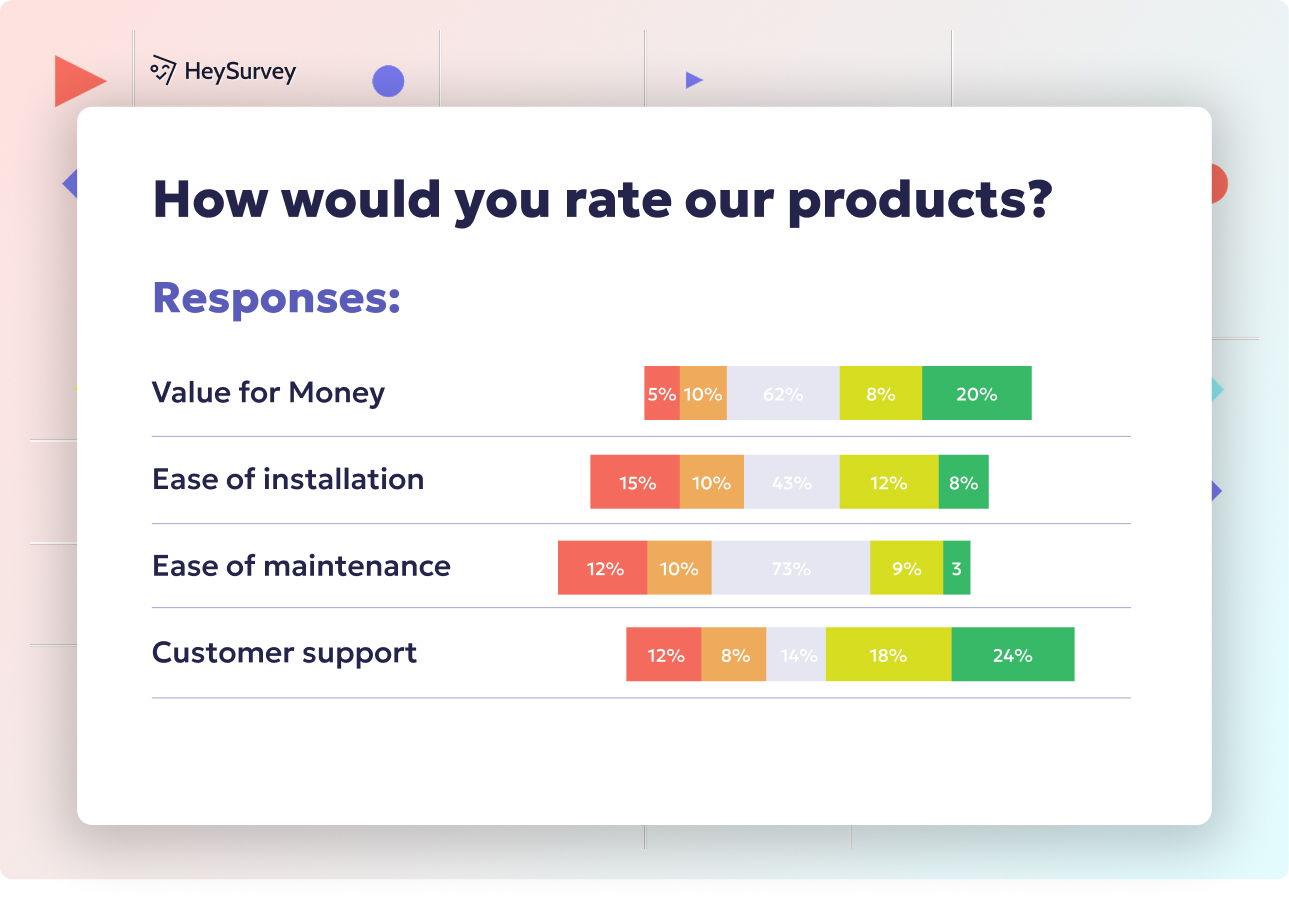
29 Cultural Competence Assessment Survey Questions for Success
Explore 30 cultural competence assessment survey questions across seven types to effectively meas...
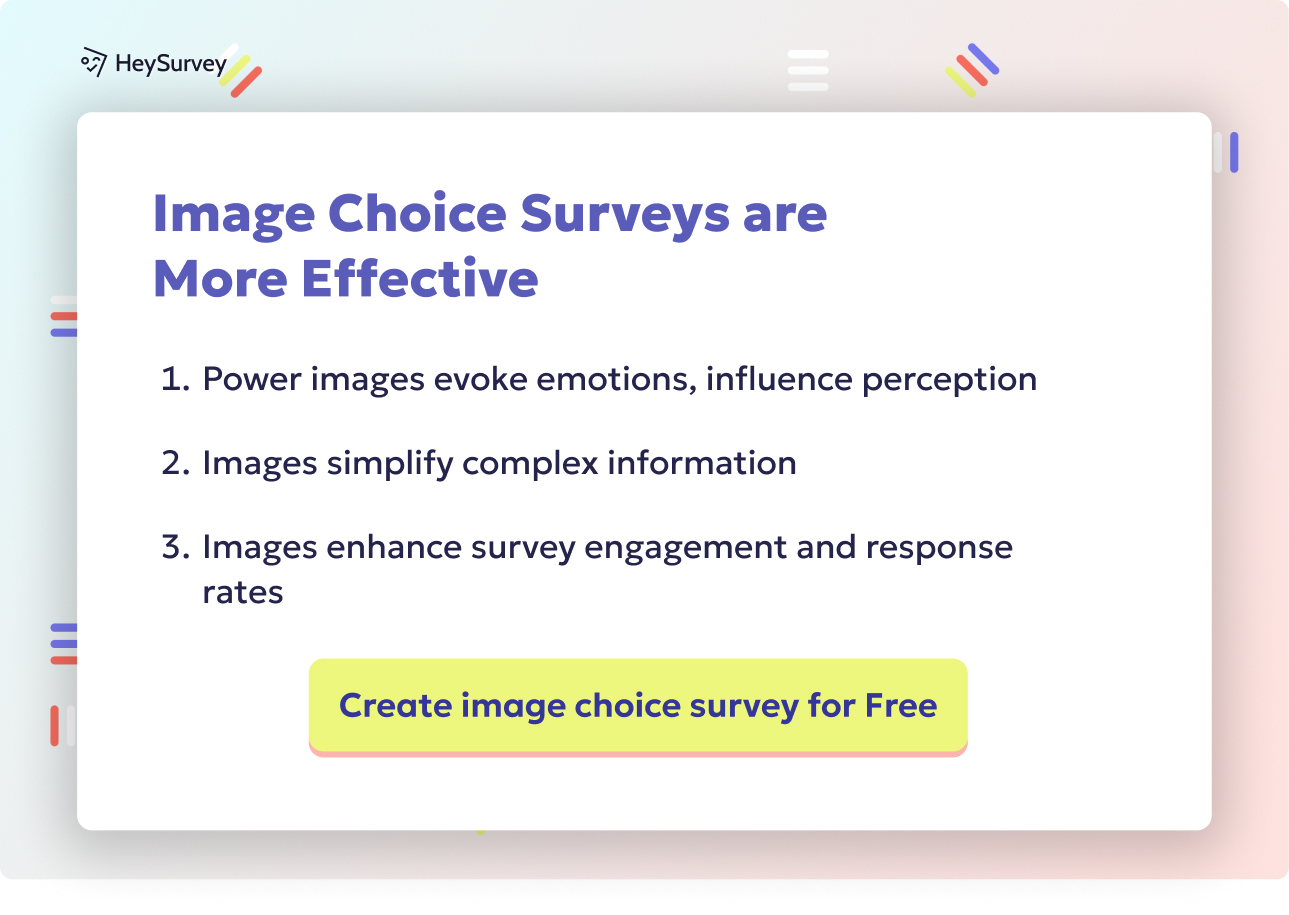
31 Religion Survey Questions: Ultimate Guide to Question Types
Explore comprehensive religion survey questions featuring 28 sample items to capture faith identi...

29 Gender Equality Survey Questions to Drive Real Change
Explore 30 insightful gender equality survey questions across workplace, education, marketing, an...
